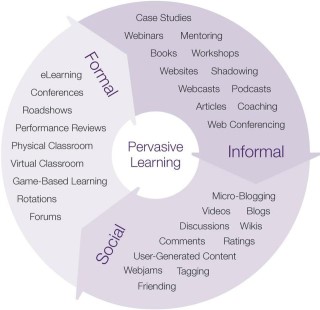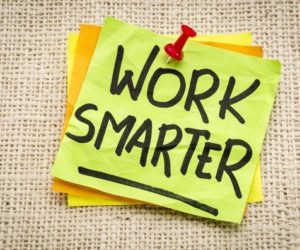I’m still Learning – (Michelangelo at 87 years old)
What is Agile learning?
Agile learning is continuous and incremental training that helps employees faster adapt to changes in an Agile environment. It helps them become more flexible, adaptable, increasing their technical and soft skills to better respond to new challenges.
Agile learning is focused on three main elements: flexibility, speed and collaboration.
An Agile organization is never static, the only constant being change. Agile projects need to be quickly developed, using new systems and techs or new ways of working. To set up an Agile project, you must promptly determine the organization to put in place. And you have to promote an Agile learning culture to speed up employees’ adaptation to change.
According to the Elearning industry website: “61% of organizations experience three or more major changes every year, but only 17% of companies consider themselves highly effective at managing change, and 30% have change and learning teams to support employees through the change process.”

There are two interconnected required ways to implement an Agile learning culture within the organization:
- On the one hand, it is essential to have good models coming from the organization’s leaders. Leaders modeling a learning culture bring two benefits to the organization. They increase their chances of better adapting to the never-ending stream of changes they face. And they promote and legitimize behaviors of learning in the entire organization.
- On the other hand, it is necessary to have an official, transparent, and well-organized learning system. And here, we are not talking about tools. The Agile learning culture encourages the employees to experiment, make mistakes, or even fail without fear, knowing that they work in a safe environment that sustains their growth. Also, the employees should feel free to ask questions, have different points of view, give & receive feedback, or debate as part of an open and growth mindset. To have a thriving agile learning culture implemented inside the company, you need employees’ buy-in, sharing the same aspirations, values, and expectations regarding the Agile learning process.
Why is agile learning crucial?
In recent years, the fundamental nature of work has been transformed. And so have HR expectations, which extended with new mandatory skills such as faster adaptation to new technology or new ways of working. Workers are required to anticipate these and quickly adapt. In this context, learning becomes a mandatory solution for professional success.
Agile learning is a winning strategy for all the parties involved:
- Employees have the support needed to develop their skills, to become better professionals and better persons. Usually, in an organization supporting agile learning, employees are encouraged to share what they’ve learned and mentor others. In this context, internal communities are created and sustained by sharing the same passions, interests, and values.
At Pentalog, multiple forms of Agile learning are provided to employees:
- Individual learning/microlearning sessions (short moments of learning during a workday);
- Peer learning with colleagues;
- Knowledge sharing sessions;
- Internal coaching sessions;
- Online training, videos, and webinars;
- Free and paid online learning platforms;
- Pentabars events;
- Dedicated internal communities.
These actions aim to improve employees’ skills and increase the cohesion between people sharing the same levels of interest.
- The Agile learning culture allows our company to be more flexible through its employees’ flexibility and adapt to new challenges by seeing them as opportunities rather than pressure or risk. Instead of hiring externally for some specific skills, Pentalog can develop them faster during the learning process.
Agile learning culture allows Pentalog to align employees’ personal goals to organizational objectives, increasing employee engagement and retention.
Implementing a robust Agile learning culture is an essential competitive advantage for any company. - There are multiple benefits of working with Agile learning teams for the clients since they are well adapted to new challenges, connected to the market trends, more creative and open-minded, and more flexible to adapt to new techs and methodologies.
Who is responsible for implementing Agile learning inside the team?
Everyone! Let’s see how members in a Scrum Team would participate in this implementation:
- The Product Owner, who is, in fact, the “CEO” of the Product, is the first one responsible for creating learning teams. He/she is the first to model learning, ask for it from the team, and design a context that promotes learning. Some Product Owners ask the team to self-organize to learn what they want while providing them the space to learn as part of the sprint backlog. Through prioritization and planning techniques, the Product Owner sustains the impact that the learning process has on the project’s success, providing the organizational environment for the team to spend time on learning during the Sprint while measuring the results.
- The Scrum Master, responsible for team efficiency and mindset, ensures that each team member understands Agile learning vision and benefits. He/she also helps the Product Owner understand the importance of learning activities and ensures that the context for learning exists and is part of the Sprints. The Scrum Master is also a guardian of the learning process by supporting the learning process, the objectives, and the results of each team member.
- The employee is the primary beneficiary of the Agile learning process. Since people are learners, the learning process is a fundamental characteristic of the human being. But even so, there are situations when the employees say that they do not have enough time for learning (according to LinkedIn’s 2018 Workplace Learning Report, this is the 1st reason for which the employees do not learn). The lack of time is not always the leading cause; instead, it is the employees’ demotivation to learn something new or prioritize these activities.
Thus, the Product Owner, Scrum Master, and employee involved in the agile learning process have equal responsibilities for the success of the agile learning implementation.
What traits are helping in the agile learning process?
There are some needed skills in the Agile learning process, such as:
- Curiosity – the interest in a specific topic increases the chances of faster assimilation of new knowledge.
- Determination is not sufficient to be curious about a specific topic if you are not prepared to allocate enough time to learn more about it and prioritize it accordingly.
- Organized thinking – it is recommended to organize your learning process by establishing the objectives, researching, collecting data, running experiments, documenting the progress, analyzing the results, formulating conclusions, and presenting the findings to other team members during knowledge-sharing sessions.
- Commitment to continuous improvement – the learning process is an ongoing one, and the natural desire for continuous improvement is the foundation of Agile Learning.
How to organize agile learning?
Learning should be integrated into the team workflow. In an Agile environment, one option could be for each employee to establish, per quarter, specific OKRs associated with his/her learning process.
The Product Owner provides the learning visibility on the Sprint backlog, creating dedicated items and allocating time for it during every Sprint (ex. 4 hours for a Sprint of 2 weeks).
Also, the “just in time” learning system is sustained, meaning that the employees access the training they need when they need it.
Tools / Methods / Materials
Several dedicated software can be used in the Agile learning process like Jira, Asana, Monday.com, Trello.
Regarding the learning methods, according to the Agile Alliance, there are six learning areas that an employee could follow, such as Individual, Intra-Team, Inter-Team, Organizational, Global, Fearless learning.

Source: https://www.agilealliance.org/resources/experience-reports/learning-agile-the-neverending-story/
In terms of materials that could be used in a persuasive learning process, Dan Pontefract suggests, in his book “Flat Army: Creating a Connected and Engaged Organisation” that there are plenty of types of learning materials such as case studies books, mentoring, videos, blog articles, forums.
Choosing the type of materials that respond best to your need could be engaging and represent an essential part of a successful learning process.
What are the topics covered by the Agile learning process?
The beauty of the Agile learning process is that everyone is free to establish the learning topic, the keys results, and the learning cadence according to his/her interests, to bring more value to the project.
But there are situations when the Product Owner or the Scrum Master require specific expertise inside the team that the Agile learning process must cover.
Thus, Agile learning is an enabler of the personal, social and professional development of the employees.
However, in most cases, the learning process refers to developing technical or specific skills required by the product or the market.
Soft skills could be an essential learning topic for employees since they weigh more and more on the labor market. Having a positive attitude, excellent communication skills, being creative, adapting quickly to new situations, managing time, and working well under pressure are some of the mandatory skills for the success of any project.
Hence, the agile learning process aims to improve the knowledge on a specific topic, learn something new, or improve soft skills. It helps people become a better version of themselves and increases their work’s value on the product.
Takeaways:
- Learning is a prerequisite for progress. Even if it is a theoretical or an experimental one, learning is the key to understand better, adapt, and respond successfully to what’s new for any employee.
- Agile learning is a win-win process, having multiple benefits for employees, the organization, and its clients.
Read also:

 (16 votes, average: 4.63 out of 5)
(16 votes, average: 4.63 out of 5)








